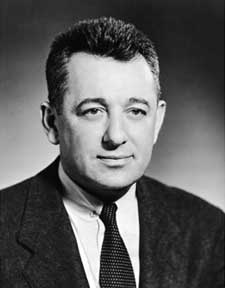Albright-Knox Art Gallery ............... Marine Midland Bank
Gordon Bunshaft in Buffalo, NY

1909-1990
Excerpt: The Gallery Architects: Edward B. Green and Gordon Bunshaft
By John Douglas Sanford
In 1957, responding to the need to expand the Albright Art Gallery, knowledgeable local inhabitants suggested reviving E.B. Green's 1942 plans for extending the Gallery, but these were thought unsuitable. Seymour H. Knox, the Academy's president and a great benefactor of the Gallery, purportedly discussed the project with Martha Jackson, a New York art gallery owner and former Buffalo resident. Jackson suggested Skidmore, Owings and Merrill and, in particular, architect Gordon Bunshaft.
Skidmore, Owings and Merrill, the largest architectural partnership in the world, had in 1956 a staff consisting of over 700 people, 200 of whom were draftsmen, while ninety-four were registered architects. The essential approach in design and construction was and is based on the team principle, with a full partner supervising each project. In advocating somewhat anonymous design teams, rather than a more personalized approach, the firm responded to Walter Gropius' call for modern production methods in achieving architecture without egotism.
The firm's use of concrete, glass and steel and the elegant simplicity of their designs bring to mind the work of Mies van der Rohe. Several of Mies' designs were included in a 1932 exhibition of International Style architecture entitled Modern Architecture International Exhibition, which was organized by the Museum of Modern Art and which traveled to the Albright Art Gallery. The International Style, characterized by its use of modern materials that enabled large buildings to be constructed with a strong skeleton covered by a light exterior skin, valued simplicity, flexibility and regularity in design. Mies' Museum for a Small City ( 1942), exhibited at the Museum of Modern Art in 1947, shares some broad similarities with Bunshaft's Gallery addition.
Gordon Bunshaft is undoubtedly one of the most highly respected and influential architects in America; his buildings are better known, however, than is his name. Bunshaft attended Lafayette High School in Buffalo and subsequently studied architecture at the Massachusetts Institute of Technology, where he received a Master of Arts diploma in Architecture in 1935. In 1937 he joined the then new firm of Skidmore, Owings and Merrill as a chief designer and became a full partner in the firm in [?].
Bunshaft's first great success was Lever House (1951-52), the first really modern International Style corporate headquarters in New York. Lever House set the standard in American architecture for at least five years, and was the model for much of the urban glass-box architecture during the 1950s.
A partial list of Bunshaft's most famous structures includes the Istanbul Hilton Hotel in Turkey (1955); the Connecticut General Life Insurance Company Building, Bloomfield (1957); the Chase Manhattan Bank, New York (1961); the Beinecke Rare Book and Manuscript Library at Yale University (1965); the Marine Midland Building, New York (1967); the Johnson Presidential Library, University of Texas, Austin (1970); and his most criticized work, the curve-fronted office towers between Fifth Avenue and the Avenue of the Americas and between 57th and 58th Streets, New York (1972). He also designed the Hirshhorn Museum and Sculpture Garden, Washington, D.C. (1974) and, as a member of the Fine Arts Commission, helped select the museum's site.
While Bunshaft's earlier work exemplified steel and glass as "the natural building materials in this country," his later buildings, beginning with the Banque Lambert in Brussels and continuing with the Beinecke and Johnson libraries, made use of pre-stressed concrete, allowing for greater freedom of shape.
By 1955 Gordon Bunshaft had received the First Prize for architecture from the National Academy of Design and was chief of design in Skidmore, Owings and Merrill's New York office. But it was his Connecticut General Building, with its sleek glass facade, that most impressed the directors of the Buffalo Fine Arts Academy.
Skidmore, Owings and Merrill received the commission and Bunshaft was chosen as the partner in charge of design for the Gallery's new addition, which was completed by the winter of 1961. Formal dedication ceremonies extended over an entire week in January 1962 and included symposia, concerts, dinners of public and private celebration and a grand ball held at the Country Club of Buffalo.
The Knox Addition
Bunshaft's addition to the Albright Art Gallery works because it both separates and combines the old and the new in a balanced relationship. The white exterior walls of the addition lead from the base of the original facade to distance the box from E. B. Green's work. The addition continues the tradition of the International Style, a movement that changed forever the skylines of cities throughout the world, but which has, since the 1970s, experienced a critical backlash in the form of Post-Modern architecture, a more decorative style that often quotes various historical periods in unorthodox ways. The "greenhouse brutalism" of contemporary architects like l.M. Pei, Kevin Roche and John Dinkeloo has been chosen in recent years for major additions to museums such as the National Gallery, Washington, D.C. andthe Metropolitan Museum of Art, New York. It would be difficult to imagine, however, such recent architectural styles in direct combination with the reverent work of Edward B. Green. Bunshaft's addition is modest and restrained and complements, rather than competes with, Green's design.
[In the 1960s, Bunshaft remodeled the interior of another building originally designed by Green and Sons, the Marine National Bank Building on Main Street.]
